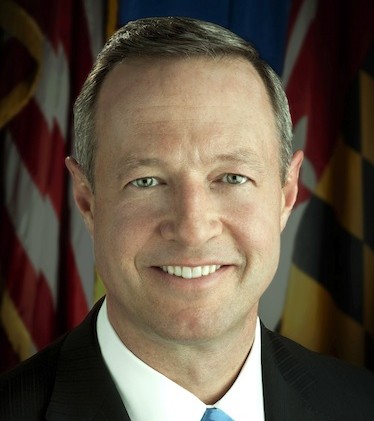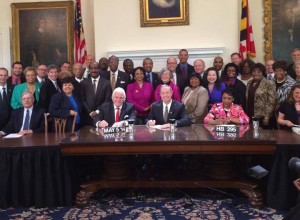
O’Malley Signs Bill to Raise Minimum Wage
Together with Senate President Mike Miller and House Speaker Pro Tem Adrienne Jones, Governor O’Malley signed bills to expand opportunity and grow Maryland’s economy. Today’s signing builds on the O’Malley-Brown Administration’s efforts to strengthen and grow Maryland’s middle class, and help lift people out of poverty. Labor Secretary Tom Perez joined advocates, business and elected leaders from across Maryland to celebrate the fact that Maryland raised the minimum wage.The signing at the State House included the centerpiece of the Administration’s legislative agenda for the 2014 General Assembly session: increasing Maryland’s minimum wage to $10.10. Raising the minimum wage will benefit hundreds of thousands of Marylanders who will receive an increase in their incomes. It will also help generate millions of dollars in new economic activity during the phase-in period and help stimulate the creation of more jobs as consumer demand grows.
“For the last eight years, the O’Malley-Brown Administration’s North Star has been strengthening Maryland’s middle class and helping to lift families out of poverty. That’s why the Lt. Governor and I led the fight to raise the minimum wage,” said Governor O’Malley. “Working together with members of the General Assembly and Maryland’s congressional delegation, we brought people together and forged consensus to increase the minimum wage to $10.10. This will boost the incomes of hundreds of thousands of hardworking Marylanders and inject millions of dollars into our State’s economy.”
“Raising the minimum wage is a critical part of ensuring that no matter where you live in our state, you have the opportunity to earn a family-supporting wage,” Lt. Governor Anthony Brown commented. “With the signing of this legislation today, we’re going to generate nearly half a billion dollars in increased economic activity for Maryland. We will strengthen our communities and help more Marylanders climb the ladder of opportunity towards the middle class.”
Maryland joins 21 states and the District of Columbia with minimum wage rates higher than the federal level of $7.25 per hour. At $10.10, Maryland, along with Connecticut, will have the highest state minimum wage in the nation upon full implementation of the increase. Labor Secretary Tom Perez attended the bill signing ceremony, offering praise for Maryland’s efforts to expand opportunity, even as the State faced the worst national recession since the Great Depression.
“Raising the minimum wage is a win-win-win. It’s good for workers, who no longer have to choose between buying a gallon of milk or a gallon of gas. It’s good for employers — many of whom have told me they support raising the wage because it makes their workers more productive. And it’s the good for the economy, because it puts more money in the pockets of workers, who spend it in their communities,” said U.S. Secretary of Labor Thomas E. Perez. “I’m proud of the leaders and policymakers in my home state for their ability to come together to forge a consensus and give Maryland workers a raise. I hope Congress will follow their lead.”
Governor O’Malley also signed a bill to expand the refundable earned income tax credit from 25 percent to 28 percent over the next four years. The bill follows up on the Administration-led expansion in 2007, and will put even more money in the pockets of Maryland workers and families.
Building on the Administration’s efforts to ensure upward economic mobility, Governor O’Malley signed a bill setting a new prevailing wage for state-sponsored school construction projects in Maryland. The bill requires all school construction projects that cost over $500,000 and receive funding of 25 percent or more from the State to pay workers the “prevailing wage”– a wage that reflects pay workers commonly receive in the project area.
Over the last eight years, Maryland has undertaken a number of efforts to strengthen and grow the State’s middle class. In 2007, Governor O’Malley signed into law the nation’s first living wage for State contracts. As part of the Administration’s 2014 legislative agenda, Governor O’Malley and Lt. Governor Brown expanded prekindergarten for up to 1,600 Maryland children and through record investments, supported strategies to improve education in Maryland’s number-one-in-the-nation public schools.
To make college more affordable for more families, the Administration made strategic investments in Maryland’s universities. In fact, Maryland has done more than any other state in the nation since 2007-08 to hold down the cost of college, according to College Board. And recognizing the importance of creating more family-sustaining jobs, Governor O’Malley signed the Transportation Infrastructure Investment Act into law, which is putting tens of thousands of Marylanders to work building roads, bridges, and transit projects in every corner of the State.


Engage us on Facebook
Follow us on Twitter
Tweets by @mymcmedia